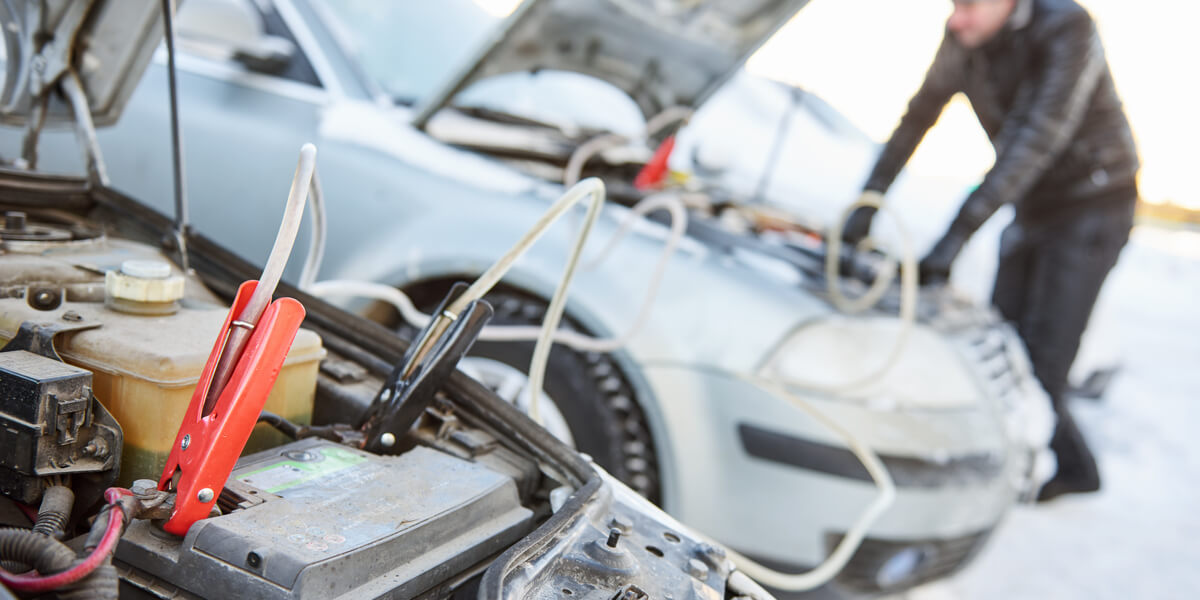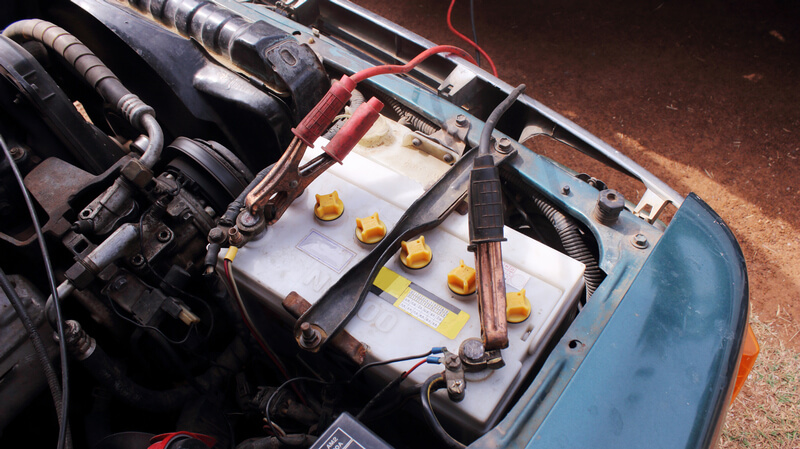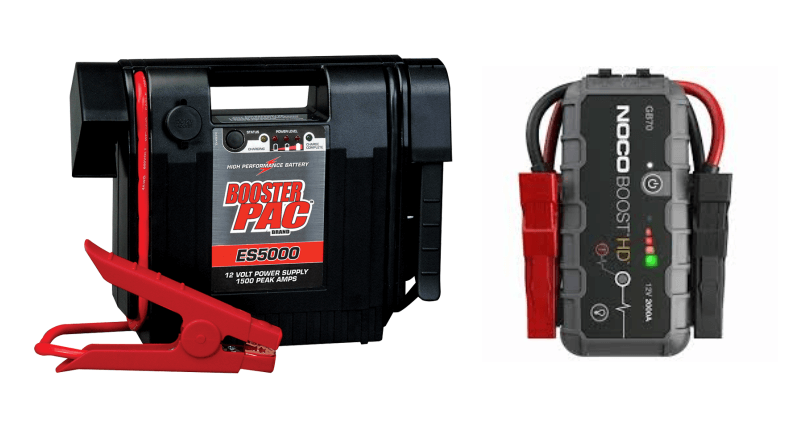
COVID-19 has seemingly brought the entire world to a halt. That includes the vehicle you haven't driven in a while. If your vehicle sits for a prolonged period, your vehicle's battery can suffer. If your car didn't start this morning or if you just want to add this useful skill to your auto mechanic skillset, here's everything you need to know about how to jumpstart a car. So, let's get into it.
Different Type of Jumper Cables
First off, there are different types of jumper cables ---- high, low, long, short. However, any pair of jumper cables is better than none in an emergency. That being said let us delve into jumper cables in more detail.
Jumper cables labeled “heavy-duty” can be misleading. The gauge is what is more important to look at. The higher the number of the gauge does not necessarily equal better. In fact, it's literally the opposite since the gauge number is inversely proportional to the size. For example, a 10 gauge cable won't give you enough oomph to jumpstart some vehicles. However, a 6 gauge will provide more than enough juice, unless you are trying to jumpstart a dump truck. Your vehicle will charge faster the lower the gauge number on the cable is. Usually, 4 to 6 gauge is the best to look for.
When shopping for jumper cables, look for one with solid clamps that have teeth that look strong and able to maintain a good connection with the battery. Rubber coated handles help in preventing electrical shocks. When choosing a length, 12 feet of cable is a good starting length, longer would be better. However, if money is an issue, 12 feet is adequate to do the job in most situations. The heavier duty the cable, the more durable it will be. However, with an increase in durability usually comes with a larger price tag.
Safety First!
When using jumper cables, keep both ends separate so they don't touch and keep the red and the black clamps from touching. If the clamps end up touching when they're hot, it could cause a short in either vehicle and a spark which may cause a dangerous situation.

How to Jumpstart a Car Using another Car
Setting up the cars
The first step is to open up your hood, or trunk depending on your vehicle, and familiarize yourself with the contents under it. Identify where the battery is. Sometimes the battery is covered by a plastic cover. Do this in both vehicles. Once you remove the cover (if there is one), identify the positive (+) and negative (-) battery terminals. If colored, red means positive, and the black means negative.
You'll probably need to clean off the battery terminals to ensure there will be a good, strong connection. Make sure none of the clamps are touching each other before hooking the red clamp to the positive (+) terminal on the dead battery.
Connecting the Negative Jumper Cable
Whenever connecting jumper cables, or even when removing or installing battery terminals, always connect and disconnect the negative side first. Doing so will prevent producing sparks and power surges if the positive cable was to touch the car body or the other clamp. Start by attaching the negative (-) clamp to the negative terminal of the live battery. Connect the other end of the negative cable to a good body ground connection on the car with the dead battery. Many vehicles have just such a bolt sticking up from the suspension shock tower. If your car doesn't have one, you can always hook up the negative clamp on the alternator bracket. Any thick metal part connected to the engine block or the transmission will do. Make sure the metal part is exempt from paint as it may cause a bad connection.
If you can see the main engine or transmission ground wire, connecting the negative jumper cable to the ground wire bolt is usually your best bet.
Connecting the Positive Jumper Cable
Connecting the positive side is a lot easier. Start by connecting one end of the positive jumper cable to the dead battery's positive terminal. Once it's done, all there is left to do is to connect the other end to the live battery's positive terminal.
Starting the Cars
Now, double-check to make sure all cables are clear of moving parts. If everything looks good, it's time to start the vehicle with the good battery. Let it run for a few minutes to charge up the dead battery. Then, try starting the vehicle with the dead battery. If it fails to start, let the battery charge for a few more minutes and try to start it again. If the vehicle with the good battery is smaller than the dead battery one, like if you are trying to jumpstart and F-150 using a Toyota Yaris, stepping slightly on the gas pedal to increase the rpm might help.
Retry it after a couple of minutes. If the car doesn't start, it can mean 3 things:
- The jumper cables might not be correctly connected. Make sure the negative cables correctly touch a metal part. Turning the clamp and moving it a bit might help.
- The car used to jumpstart the dead car might not have a battery big enough to do the job.
- If everything else seems good, a clicking sound when trying to start the vehicle may be the result of a bad starter. Obviously, a faulty starter won't work, no matter whether it's connected to a good or bad battery.
If the vehicle starts, let it run for a while to let the alternator recharge the battery.
Disconnecting the Jumper Cables
Now for the disconnecting part, start by disconnecting the negative clamp from the ground bolt. Then disconnect the red clamp, do not let them touch. It's best to place them on the ground separated. The red clamp on the vehicle with the good battery is next. The last clamp should be the black one on the good battery. You've now officially and successfully jumpstarted your vehicle.
 Different types of booster packs.
Different types of booster packs.How to Jumpstart a Car Using a Booster Pack
The easiest way to jumpstart a car is by using a booster pack. Keeping one in your trunk is also the safest way to ensure you never get stranded because of a dead battery.
To jumpstart your dead car battery using a booster pack, simply connect the negative clamp to a ground bolt and connect the positive clamp to the battery's positive terminal. Turn the booster pack on and crank the engine.
Once it's started, remove both clamps and that's it!
Most booster packs only store enough power to start a car 2 or 3 times so don't forget to charge it back before putting it back in your trunk.
Get a booster pack to jump start your car in emergency situations.
Testing your Car's Charging System
Batteries rarely die out for no reason. Unfortunately, many charging system faults might be at fault here. For example, there might be a voltage drain consuming power when the key is turned off. A faulty alternator might also incorrectly recharge the battery. With time, the cells inside the battery may also degrade and stop doing their job.
In all cases, you'll want to test your charging system as soon as it's possible. Even though jumpstarting a battery will allow your engine to start, a faulty battery or a voltage drain will cause the same condition to open the next time you want to start your car. You can always test your alternator output using a multimeter.
You'll want to make sure the battery itself is ok too. You can always measure the voltage of the battery when the engine is off and idling to know if it's in good working condition. The base voltage may vary depending on the car model but, as a general rule, the voltage should be around 12.6v when the engine is turned off and over 13v when idling. If the voltage reading is lower than that, there might be a problem with your charging system. However, good voltage readings might not be sufficient. It's not uncommon for faulty car batteries to show good voltage readings while not producing enough amps to start the vehicle.
To test the amp output of your car battery, you'll need a battery tester. If you don't have one, stop by an auto parts store or your local independent repair shop. Both will usually be more than happy to test your charging system for free in the hope of selling you some replacement parts if something's not right. However, you can always ask for an estimate, buy the parts you need and replace it yourself back at home. If you a lucky, the problem will be related to the battery and not the alternator. Faulty alternators are usually much more expensive to replace than a bad battery.
Last Words
Jumpstarting a car is a daunting experience for the uninformed, but it's an invaluable skill to have in your skillset. I know that, for me, anything that involves electricity is a bit scary. However, keep in mind that a 12v system cannot shock people. Furthermore, following the procedure outlined above will ensure that you stay safe and don't break anything. It's important to remember that mishandling jumper cables could cause a power surge that could damage fragile electronic components. When in doubt, take a look at your car's repair manual to learn more about the manufacturer's recommended procedure. Doing so is always the best way to perform repairs and make sure you save as much money as possible while doing it.
Good luck!
